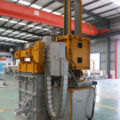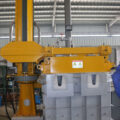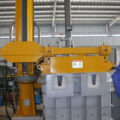The most remarkable features of box type degasser for aluminum are graphite stator and graphite rotor / rotor structure. The graphite stator does not rotate in the liquid aluminum, which can protect the graphite rotor / rotor assembly. The graphite rod and the graphite rotor are assembled together to stir the aluminum water. Through the gap between the stator and the graphite rod, inert gas is sprayed into the liquid aluminum from the grooves at the bottom edge of the stator and the top edge of the graphite rotor. AdTech offers box type degassing unit for aluminum foundries.
Trough type degasser for aluminum is used for degassing and refining by rotating rotor / rotating rod. The main difference between the trough degasser and the box degasser is that the substrate in the degassing tank of the chute degasser is flush with the substrate in the launder of the casting production line, so that there is no residual aluminum in the degasser.
The sealing cover and degassing groove of the chute type degasser form a relatively sealed space. During casting, the molten aluminum enters the degassing tank by subsurface flow. When the liquid aluminum level in the degassing tank is higher than 200 mm, the rotor starts to stir the liquid aluminum, and injects inert gas into the liquid aluminum to degas and refine the aluminum liquid in the degassing tank.
Compared with the traditional box type degasser, the chute type degasser has the advantages of no residual aluminum and small floor space. Its disadvantages are also obvious: due to the shallow depth of liquid aluminum and the short residence time of bubbles in liquid aluminum, the degassing effect of flume degasser is slightly lower than that of box type degasser.

Since there is no heating system, the temperature of molten aluminum will decrease when passing through degassing tank (generally 10-35 ℃), which affects the subsequent casting process. The rotating speed of graphite rod / rotor of flume degasser is very high (> 1000r / min), so the service life of graphite rod / rotor is shorter and more slag is formed. Due to the short residence time of bubbles in molten aluminum, the degassing effect is affected. The operator usually offsets the adverse effect by increasing the flow rate of inert gas, which leads to a large consumption of inert gas.
The structure of vacuum degasser for aluminum is similar to that of trough type degasser, which is divided into degassing tank and vacuum degassing chamber. The vacuum degassing chamber can be divided into single chamber, double chamber and multi chamber according to the different velocity of liquid aluminum. The graphite rotor of the vacuum degasser is installed at the bottom of the degassing chamber. A slot is arranged at the bottom of the degassing chamber to make the vacuum degassing chamber communicated with the degassing tank. When the aluminum liquid flows through the degassing tank, the degassing chamber will form negative pressure under the action of vacuum pump or other methods, so as to enhance the liquid aluminum level in the vacuum degassing chamber. When the liquid aluminum level reaches a certain height, the graphite rotor starts to rotate and spray inert gas to degassing and refining aluminum liquid. When degassing is finished, the negative pressure in the vacuum chamber is removed, and the liquid aluminum level in the vacuum chamber drops until it is level with the liquid level in the degassing tank.
The vacuum degasser has the advantages of no residual aluminum and small space. In addition, because the liquid aluminum is degassed and stirred in vacuum, less oxide is produced and the liquid aluminum is relatively clean.
The disadvantages of vacuum degasser are as follows: 1) the cleanliness of liquid aluminum is high; 2) the graphite rotor is easy to wear due to the fact that the graphite rotor is installed at the bottom and there are many slag at the bottom of the aluminum liquid.







